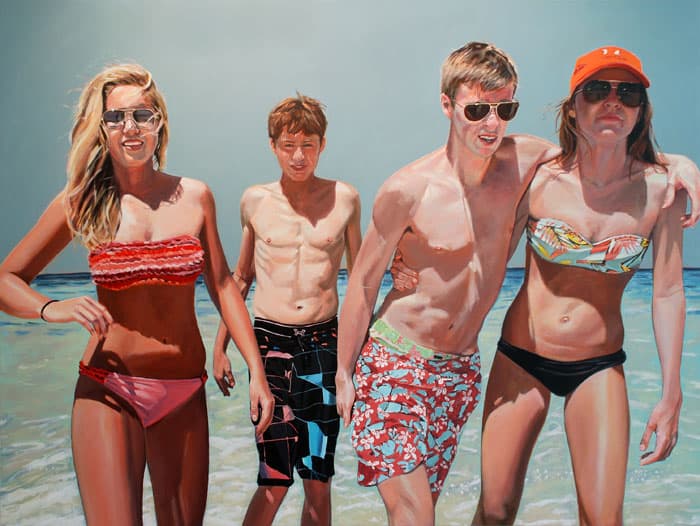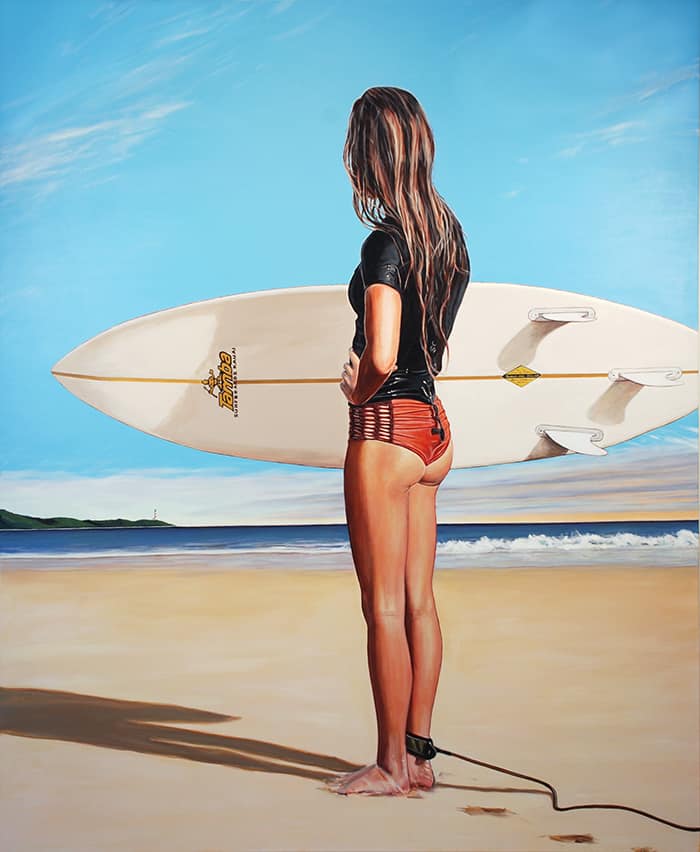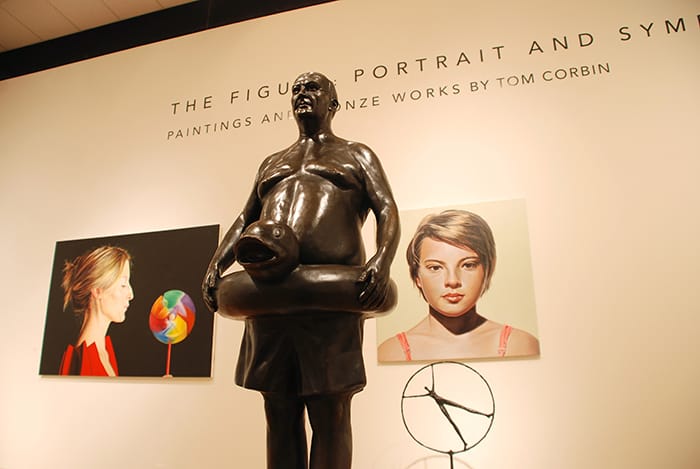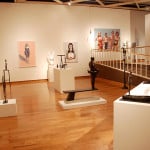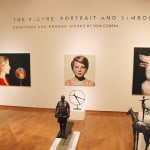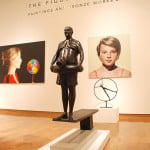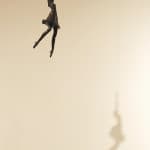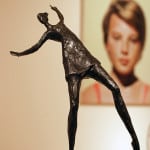The Figure: Portrait and Symbol
Paintings and Bronze Works by Tom Corbin
The University of Mississippi Museum Show, Mar. 18 – Aug. 9, 2014
Essay by Dana Self
Tom Corbin’s work occupies a space of utopianism, where perfection and the memory of perfection live. His female forms, family members and pets, and the carefree young people of his paintings, are suspended in moments of freedom and memory’s idealization. In this body of work, Corbin presents paintings and sculptures that combine new experimentation with his signature style and techniques.
Certain rites of passage and poignant memories emerge in Corbin’s work. A young girl mowing the yard, or looking out to the ocean with a surfboard tucked under her arm, the beloved family pet; these images coalesce into the nostalgia that often attends autobiography. Corbin’s best work is intimate, yet widely understood: family, friends, quotidian experiences, and the exploration of figures and forms in spatial relationship to one another.
Paintings
Corbin’s paintings of family and friends share an unapologetic love of familial relationships and of the ordinary experiences that construct a life. In Seven Mile Beach, four young people pose on the beach, casually arranged for a photo op. Sunglasses on, young, and happy, they have emerged from the water as the picture of youth and vitality. Rendered in his naturalistic painting style, Corbin’s figures are pressed up against the surface of the picture plane, alive and headed toward us, as if beckoning us to join them.
In The Lighthouse, a young woman stands, back to us, as she stares out into the surf. Our view is hers; fixed on the distant, blue horizon line. As in Seven Mile Beach, this image suggests the “endless summer” of youth and vitality, when time slows and all things seem possible. Corbin’s paintings often act as mementos of his personal history and experience. Through these images, he constructs memory, meaning, and continuity as perhaps a hedge against change and uncertainty.
Portraits
In a curious way, all of Tom Corbin’s paintings and sculptures, and even his furniture, are portraits. They are portraits of people, places, beloved memories, and admired objects. Even Roxy, the family’s standard poodle, is represented, painted monumentally in classic profile against a black background.
Corbin’s works operate as intimate exchanges between the artist, the subject, and the audience. We learn what the artist wants us to learn of any certain person, place, or thing, and the rest is conjecture based on our experiences and assumptions. The identities of his iconic figures are fixed as allegorical female forms, while the paintings are more personal and inward looking.
Some portraits combine the two approaches, as in the painting Blue Sky. In this simple painting, a female stands in the painting’s center, wearing a yellow dress, framed against a brilliant blue background. Here, Corbin’s paint handling is loose and free, a contrast to his more controlled realistic portraits. This woman is unidentifiable, as Corbin’s focus is on the open brushwork and loose strokes that comprise the figure. Blue Sky is emblematic of the intersection of Corbin’s personal and allegorical works.
The Environments Series
In this exhibition Corbin has expanded the vocabulary of his bronze sculptures. While he still maintains a classicist’s devotion to the female form and the elongated figures for which he is known, his Environments Series comprises more broadly narrative sculptures, in which he places active figures in site-specific scenes.
Man on Diving Board exemplifies the Environments Series. A portly, middle-aged man stands on the end of a diving board contemplating the water below. Corbin has portrayed the man wearing a child’s floaty duck tube around his waist, which he casually holds as if it is the most obvious accompaniment. He treats this mature, naturalistic body with the same respect as he does his idealized female nude figures, and the young people in his paintings. The man’s relaxed pose elevates him to an almost heroic, rather than comic stature, as his stance suggests the comfort we may achieve in our middle years if vanity gives way to acceptance and gratitude for our health and well being.
Man on Diving Board is a sharp contrast to the bronze Girl with Lawnmower, one of Corbin’s classical female figures (in a minidress) who pushes a lawnmower, or Girl on Boat, in which a nude figure balances on the back of a rowboat.
In Woman at the Center, Corbin experiments with the implied picture plane by centering his nude figure within a circle. The sculpture, part of his Screen Series, feels more like an enhanced bas-relief, or, as his series title suggests, an implied screen that has been penetrated by the human figure.
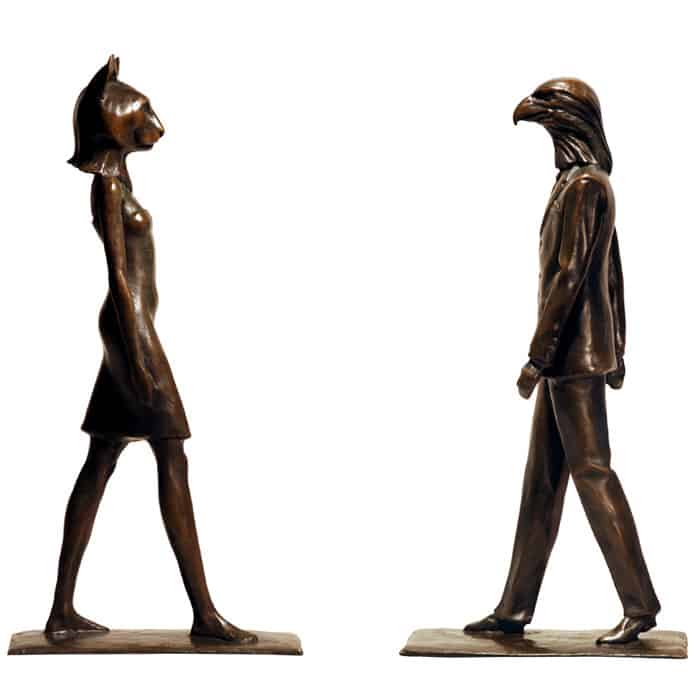
The Primitive Series
Corbin moves between past and present with ease. His Primitive Series excavates historical imagery and symbols. The Hiero-Man and Hiero-Woman sculptures, which sport hawk and cat-heads, are a nod toward Egyptian art, as is Bronze Bunnee, which combines two recognizable icons, the ancient sphinx and the loveable Bugs Bunny.
The artist’s sculptures and paintings share an economy of line. Corbin pares forms to their most minimal without stripping them of their essential humanity. An elongated leg, neck, and arms suggest the feminine, yet also strength and resilience, in the same way that his decorative furniture is inventive yet fully functional. While Corbin works with the nude figure, the results are never overtly sexual or sexualized, but instead embody nature’s earthy fecundity.
Tom Corbin’s images and ideas are nimble and mobile, shifting, as he does, between painted and sculptural form and between past and present. His tight figural veracity and the emotional resonance of his themes binds his various works together. Family, memory, shared experience, nostalgia, and formal exploration support, define, and impart his work with universal resonance.
—Dana Self, Kansas City, MO
The exhibition continues through August 9, 2014. Visit The University of Mississippi Museum website for more information



